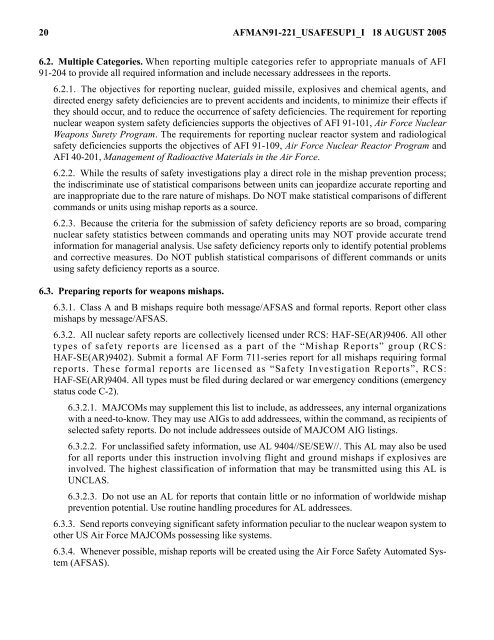USAFE: Safety - BITS
USAFE: Safety - BITS
USAFE: Safety - BITS
Create successful ePaper yourself
Turn your PDF publications into a flip-book with our unique Google optimized e-Paper software.
20 AFMAN91-221_<strong>USAFE</strong>SUP1_I 18 AUGUST 2005<br />
6.2. Multiple Categories. When reporting multiple categories refer to appropriate manuals of AFI<br />
91-204 to provide all required information and include necessary addressees in the reports.<br />
6.2.1. The objectives for reporting nuclear, guided missile, explosives and chemical agents, and<br />
directed energy safety deficiencies are to prevent accidents and incidents, to minimize their effects if<br />
they should occur, and to reduce the occurrence of safety deficiencies. The requirement for reporting<br />
nuclear weapon system safety deficiencies supports the objectives of AFI 91-101, Air Force Nuclear<br />
Weapons Surety Program. The requirements for reporting nuclear reactor system and radiological<br />
safety deficiencies supports the objectives of AFI 91-109, Air Force Nuclear Reactor Program and<br />
AFI 40-201, Management of Radioactive Materials in the Air Force.<br />
6.2.2. While the results of safety investigations play a direct role in the mishap prevention process;<br />
the indiscriminate use of statistical comparisons between units can jeopardize accurate reporting and<br />
are inappropriate due to the rare nature of mishaps. Do NOT make statistical comparisons of different<br />
commands or units using mishap reports as a source.<br />
6.2.3. Because the criteria for the submission of safety deficiency reports are so broad, comparing<br />
nuclear safety statistics between commands and operating units may NOT provide accurate trend<br />
information for managerial analysis. Use safety deficiency reports only to identify potential problems<br />
and corrective measures. Do NOT publish statistical comparisons of different commands or units<br />
using safety deficiency reports as a source.<br />
6.3. Preparing reports for weapons mishaps.<br />
6.3.1. Class A and B mishaps require both message/AFSAS and formal reports. Report other class<br />
mishaps by message/AFSAS.<br />
6.3.2. All nuclear safety reports are collectively licensed under RCS: HAF-SE(AR)9406. All other<br />
types of safety reports are licensed as a part of the “Mishap Reports” group (RCS:<br />
HAF-SE(AR)9402). Submit a formal AF Form 711-series report for all mishaps requiring formal<br />
reports. These formal reports are licensed as “<strong>Safety</strong> Investigation Reports”, RCS:<br />
HAF-SE(AR)9404. All types must be filed during declared or war emergency conditions (emergency<br />
status code C-2).<br />
6.3.2.1. MAJCOMs may supplement this list to include, as addressees, any internal organizations<br />
with a need-to-know. They may use AIGs to add addressees, within the command, as recipients of<br />
selected safety reports. Do not include addressees outside of MAJCOM AIG listings.<br />
6.3.2.2. For unclassified safety information, use AL 9404//SE/SEW//. This AL may also be used<br />
for all reports under this instruction involving flight and ground mishaps if explosives are<br />
involved. The highest classification of information that may be transmitted using this AL is<br />
UNCLAS.<br />
6.3.2.3. Do not use an AL for reports that contain little or no information of worldwide mishap<br />
prevention potential. Use routine handling procedures for AL addressees.<br />
6.3.3. Send reports conveying significant safety information peculiar to the nuclear weapon system to<br />
other US Air Force MAJCOMs possessing like systems.<br />
6.3.4. Whenever possible, mishap reports will be created using the Air Force <strong>Safety</strong> Automated System<br />
(AFSAS).
















